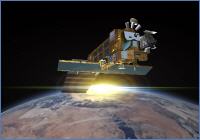20th anniversary of the Montreal protocol on substances that deplete the ozone layer

- September 16, 2007 is the 20th anniversary of the adoption of the "Montreal protocol on substances that deplete the ozone layer", an international agreement regulating the production and consumption of chemical compounds contributing to the depletion of the ozone layer. On the occasion of this anniversary this website provides an overview of important scientific contributions to the monitoring of ozone and other relevant minor constituents of the Earth atmosphere, which enable the verification of the successful implementation of the Montreal protocol.
Stratospheric ozone and CFCs
Ozone (O3) is one of the most important chemical constituents of the Earth atmosphere. The ozone molecule consists of three oxygen atoms and occurs in the atmosphere only in trace amounts (several ozone molecules per million air molecules). Despite its low abundance ozone strongly absorbs solar radiation in the UV-B (280 nm – 320 nm) and the UV-C (below 280 nm) spectral ranges. Solar radiation in the UV-C spectral range is almost entirely absorbed in the upper atmosphere, while the intensity of solar UV-B radiation at the Earth’s surface is mainly determined by the amount of ozone in the stratosphere. The DNA of all living organism is very prone to damage by solar UV-B radiation, making the stratospheric ozone layer an important protection for life on Earth. About 80% to 90% of the ozone in the Earth atmosphere is located in the stratosphere – the atmospheric layer extending from about 10 km to 50 km in altitude.
In 1973 the scientists Sherwood Rowland and Mario Molina discovered, that a set of artificially produced chlorine (Cl) compounds (CFCs or chlorofluorocarbons) is capable of severely damaging the stratospheric ozone layer. For this discovery Rowland and Molina received the Nobel price for chemistry in 1995. CFCs were widely used for different purposes, e.g. as cooling agents in refrigerators and air conditioners, or as aerosols in spray cans. Due to their chemical inertness they were considered harmless. CFCs actually pose no threat in the lowermost atmospheric layer – the troposphere – but they can be transported upwards into the stratosphere by slow atmospheric motions. In the stratosphere the intensity of energetic solar radiation is higher than near the surface, and the CFC molecules can be split into their constituents. The resulting chlorine then acts as a catalyst in the destruction of ozone molecules, i.e. ozone molecules are destroyed while chlorine is conserved:
Cl + O3 ---> ClO + O2
ClO + O ---> Cl + O2
Net: O3 + O ---> O2 + O2
The transport and distribution of the long-lived CFCs in the stratosphere is rather slow. Therefore, the stratospheric chlorine loading observed today is determined by the CFC emissions during the past 4 – 7 years. With the slow decline of the stratospheric chlorine loading related to the successful implementation of the Montreal Protocol, a recovery of the ozone layer is expected for the coming decades. Observations are already hinting at a beginning of ozone recovery, however, the natural variability of other processes, such as solar variability (12-year solar cycle) and major volcanic eruptions also contribute to ozone changes.
(next page: The Antarctic ozone hole)
|
Institute of Environmental Physics (IUP) Institut of Remote Sensing (IFE) University of Bremen, Otto-Hahn-Allee 1 28359 Bremen Deutschland contact to the IUP |

|

|